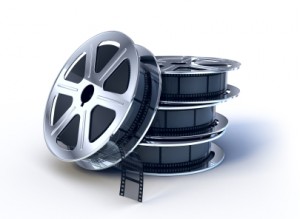Lights, camera, action! Recording a version of your presentation can draw Internet attention to what you have to say and reach many more people than a face-to-face talk. But on the Web, anyone can be a star. There is plenty of other content to compete for your audience’s attention. How can you maximize the time they spend watching your recorded presentation?
Kind of like writing, captivating the collective Web is more a matter of editing than it is a matter of creating. Of course, elements like lighting, sound quality and content are all key to any presentation recording worth watching. But assuming that you – and many others – already have this going, there are some additional steps that can keep your audience tuned in. If your production is focused, so will be their eyes on your content.
Table of Contents
Better viewership through segmented content
 The average person doesn’t watch anything for more than a few minutes online. Even when watching TV, commercials provide for a constant interruption. Modern minds are not accustomed to paying attention for extended periods of time. So as a general rule, you’ll want to keep your videos to 5 minutes or less. “Five minutes?!” you may exclaim. “But I’ve got hours of content worth watching!”
The average person doesn’t watch anything for more than a few minutes online. Even when watching TV, commercials provide for a constant interruption. Modern minds are not accustomed to paying attention for extended periods of time. So as a general rule, you’ll want to keep your videos to 5 minutes or less. “Five minutes?!” you may exclaim. “But I’ve got hours of content worth watching!”
That may be true – you may even be the Steven Spielberg of recorded PowerPoint presentations. It doesn’t matter. When browsing online, people want to get concise information that they can absorb quickly. Attention spans seem to wane on the Internet. Your goal is to optimize how much they can get from the presentation – and how much of your content you can market. This is best achieved by honing in on a very specific topic.
 If giving a longer presentation, break it up into shorter segments based on logical stopping points and design a menu to display the links to each one. This gives an added advantage of making the content 20, 30, or 40 minutes into your presentation more visible to your audience. Instead of being buried in the middle of a 1-hour video, what most interests a particular viewer is right there for them to click on.
If giving a longer presentation, break it up into shorter segments based on logical stopping points and design a menu to display the links to each one. This gives an added advantage of making the content 20, 30, or 40 minutes into your presentation more visible to your audience. Instead of being buried in the middle of a 1-hour video, what most interests a particular viewer is right there for them to click on.
Never forget your lines again
In a face-to-face presentation, you don’t have to fight for attention. Your audience is there in front of you, and while they may make idle chat with their neighbor from time to time, for the most part you’re the center of the universe for the duration of your talk. But when your webinar is recorded, there’s no unspoken agreement to pay attention.
 Reading from a script is a no-no when you’re giving a face-to-face presentation. The point then is to engage with your audience by looking at them and addressing them directly with a natural, conversational demeanor. That’s your end of the bargain. But with a presentation recording, it’s just the opposite. Captivating your audience depends on your reading from a script. Having the words right in front of you will keep you from tripping on the words your memory provides – which are sometimes wrong or not there at all. A smooth reading of exactly what you want to say is best, no matter how well you know the material.
Reading from a script is a no-no when you’re giving a face-to-face presentation. The point then is to engage with your audience by looking at them and addressing them directly with a natural, conversational demeanor. That’s your end of the bargain. But with a presentation recording, it’s just the opposite. Captivating your audience depends on your reading from a script. Having the words right in front of you will keep you from tripping on the words your memory provides – which are sometimes wrong or not there at all. A smooth reading of exactly what you want to say is best, no matter how well you know the material.
Autopilot audio will crash and burn
It sounded perfect when you read it aloud during your recording. There’s only one way to be sure: check your audio! Listen to the recording before publishing it, and edit or re-record as needed. Nothing turns away an audience like mumbling, muttering, or background noise. Without clear audio, your message won’t get across in your speech, and they’ll have to resort to reading the slides – which defeats the entire purpose of the video!
 To make editing easier, record the audio for each slide separately. That way, the producer or editor of the video can note places on each slide where sound was muffled or the speaker slipped up. Then you can just re-record the audio for that slide without having to edit one large audio file for the entire segment.
To make editing easier, record the audio for each slide separately. That way, the producer or editor of the video can note places on each slide where sound was muffled or the speaker slipped up. Then you can just re-record the audio for that slide without having to edit one large audio file for the entire segment.
Slide to slide in 60 seconds
Though the recording couldn’t be made without audio, the meat of the project is still the presentation itself – the visual candy that makes sense of the fancy talk. Your slides should be filled with captivating content and images, used appropriately but not to excess.
No matter how great the slides are, it’s bad narrative practice to let any one slide linger too long. Keeping them moving at a pace of about one slide every 60 seconds will help your audience “get” your message. You won’t want the slides to go by too quickly so that viewers don’t absorb the content; yet leaving them stuck on one slide for a long time detaches what you’re saying from the visual cue. Sixty seconds is a good length to shoot for that will give them enough time to read and be ready for the next great piece of content.



